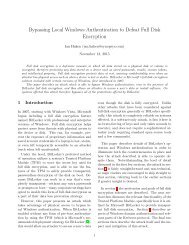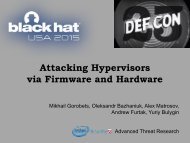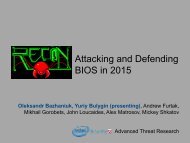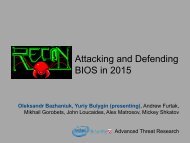Exploring Your System Deeper [with CHIPSEC] is Not Naughty
csw2017_ExploringYourSystemDeeper_updated
csw2017_ExploringYourSystemDeeper_updated
You also want an ePaper? Increase the reach of your titles
YUMPU automatically turns print PDFs into web optimized ePapers that Google loves.
<strong>Exploring</strong> <strong>Your</strong> <strong>System</strong> <strong>Deeper</strong><br />
[<strong>with</strong> <strong>CHIPSEC</strong>] <strong>is</strong> <strong>Not</strong> <strong>Naughty</strong><br />
Presenting: Oleksandr Bazhaniuk (@ABazhaniuk), Andrew Furtak<br />
Mikhail Gorobets (@mikhailgorobets), Yuriy Bulygin (@c7zero)<br />
Advanced Threat Research
Agenda<br />
Intro to firmware security<br />
Finding vulnerabilities in firmware<br />
Checking hardware protections<br />
Finding “problems” in firmware<br />
Finding vulnerabilities in hyperv<strong>is</strong>ors<br />
Conclusions
Intro to firmware security
Firmware Everywhere<br />
FW<br />
FW<br />
FW<br />
FW<br />
FW<br />
FW<br />
FW<br />
FW<br />
FW<br />
FW<br />
Image source<br />
4
Firmware Everywhere<br />
‣ GBe NIC, WiFi, Bluetooth, WiGig<br />
‣ Baseband (3G, LTE) Modems<br />
‣ Sensor Hubs<br />
‣ NFC, GPS Controllers<br />
‣ HDD/SSD<br />
‣ Keyboard and Embedded Controllers<br />
‣ Battery Gauge<br />
‣ Baseboard Management Controllers (BMC)<br />
‣ Graphics/Video<br />
‣ USB Thumb Drives, keyboards/mice<br />
‣ Chargers, adapters<br />
‣ TPM, security coprocessors<br />
‣ Routers, network appliances<br />
‣ Main system firmware (BIOS, UEFI firmware, Coreboot)<br />
5
6<br />
Why Attack Firmware?<br />
‣ Getting extreme pers<strong>is</strong>tence<br />
‣ Getting stealth<br />
‣ Bypassing OS or VMM based security<br />
‣ Having unobstructed access to hardware<br />
‣ OS independent<br />
‣ Making the system unbootable
Some In-the-wild Firmware Attacks<br />
‣ Mebromi BIOS rootkit<br />
‣ EQUATION Group HDD firmware malware<br />
‣ ] Hacking Team [ UEFI rootkit<br />
‣ Vault 7 Mac EFI implants (DerStarke/DarkMatter, Sonic Screwdriver)
<strong>CHIPSEC</strong> Framework<br />
‣ Open Source Platform Security Assessment Framework<br />
https://github.com/chipsec/chipsec<br />
‣ OS support: Windows, Linux, UEFI Shell. Added alpha version for Mac OS<br />
‣ Architecture support: x86, ARM (WIP experimental)
Finding Vulnerabilities in <strong>System</strong> Firmware<br />
(BIOS, UEFI, Mac EFI, Coreboot)
Example: S3 Boot Script Vuln in PC UEFI and Mac EFI<br />
[*] running module: chipsec.modules.common.uefi.s3bootscript<br />
[x][ =======================================================================<br />
[x][ Module: S3 Resume Boot-Script Protections<br />
[x][ =======================================================================<br />
[!] Found 1 S3 boot-script(s) in EFI variables<br />
[*] Checking S3 boot-script at 0x00000000DA88A018<br />
[!] S3 boot-script <strong>is</strong> in unprotected memory (not in SMRAM)<br />
[*] Reading S3 boot-script from memory..<br />
[*] Decoding S3 boot-script opcodes..<br />
[*] Checking entry-points of D<strong>is</strong>patch opcodes..<br />
...<br />
[-] FAILED: S3 Boot Script and entry-points of D<strong>is</strong>patch opcodes do not appear<br />
to be protected<br />
Technical Details of the S3 Resume Boot Script Vulnerabilities
Example: exploiting flash protections via S3 boot script vuln on Mac EFI<br />
Technical Details of the S3 Resume Boot Script Vulnerabilities
Example: Mac EFI leaving SMM unlocked after S3<br />
Issue. Loosing SMRAM protections after S3 sleep<br />
Step 1. chipsec_main –m common.smrr<br />
PASSED<br />
Step 2. Go to sleep. Resume from sleep<br />
Step 3. chipsec_main –m common.smrr<br />
FAILED
Testing S3 Vulnerabilities<br />
‣ Validate your system for S3 boot script vulnerabilities<br />
chipsec_main –m common.uefi.s3bootscript<br />
‣ Also run before and after resuming from sleep!<br />
chipsec_main –m common.smrr<br />
chipsec_main –m common.spi_lock<br />
[or just run all modules] chipsec_main<br />
‣ Manually test S3 boot script protections:<br />
chipsec_main –m tools.uefi.s3script_modify
Decoding S3 Boot Script Opcodes…<br />
chipsec_util uefi s3bootscript<br />
[000] Entry at offset 0x0000 (length = 0x21):<br />
Data:<br />
02 00 0f 01 00 00 00 00 00 00 c0 fe 00 00 00 00<br />
01 00 00 00 00 00 00 00 00<br />
Decoded:<br />
Opcode : S3_BOOTSCRIPT_MEM_WRITE (0x02)<br />
Width : 0x00 (1 bytes)<br />
Address: 0xFEC00000<br />
Count : 0x1<br />
Values : 0x00<br />
..<br />
[359] Entry at offset 0x2F2C (length = 0x20):<br />
Data:<br />
01 02 30 04 00 00 00 00 21 00 00 00 00 00 00 00<br />
de ff ff ff 00 00 00 00<br />
Decoded:<br />
Opcode : S3_BOOTSCRIPT_IO_READ_WRITE (0x01)<br />
Width : 0x02 (4 bytes)<br />
Address: 0x00000430<br />
Value : 0x00000021<br />
Mask : 0xFFFFFFDE
Vulnerabilities in SMM of UEFI Firmware<br />
Via ACPI table<br />
“UEFI” ACPI<br />
Phys Memory<br />
EDKII<br />
Comm Buffer<br />
SMI<br />
SMI Handlers in<br />
SMRAM<br />
Fake SMM comm buffer<br />
Directly in reg<strong>is</strong>ters<br />
RAX (code)<br />
OS Memory<br />
EDKI<br />
RBX (pointer)<br />
Exploit tricks SMI handler to write to an address in SMRAM (Attacking and Defending BIOS in 2015)
Example: Attacking hyperv<strong>is</strong>ors via SMM pointers…<br />
Via ACPI table<br />
“UEFI” ACPI<br />
Phys Memory<br />
EDKII<br />
Comm Buffer<br />
SMI<br />
SMI Handlers in<br />
SMRAM<br />
Directly in reg<strong>is</strong>ters<br />
RAX (code)<br />
OS Memory<br />
EDKI<br />
RBX (pointer)<br />
Fake SMM comm buffer<br />
VMM protected page<br />
Even though SMI handler check pointers for overlap <strong>with</strong> SMRAM, exploit can trick it to write to VMM<br />
protected page (Attacking Hyperv<strong>is</strong>ors via Firmware and Hardware)
Finding SMM “Pointer” vulnerabilities<br />
[x][ =======================================================================<br />
[x][ Module: Testing SMI handlers for pointer validation vulnerabilities<br />
[x][ =======================================================================<br />
...<br />
[*] Allocated memory buffer (to pass to SMI handlers) : 0x00000000DAAC3000<br />
[*] >>> Testing SMI handlers defined in 'smm_config.ini'..<br />
...<br />
[*] testing SMI# 0x1F (data: 0x00) SW SMI 0x1F<br />
[*] writing 0x500 bytes at 0x00000000DAAC3000<br />
> SMI 1F (data: 00)<br />
RAX: 0x5A5A5A5A5A5A5A5A<br />
RBX: 0x00000000DAAC3000<br />
RCX: 0x0000000000000000<br />
RDX: 0x5A5A5A5A5A5A5A5A<br />
RSI: 0x5A5A5A5A5A5A5A5A<br />
RDI: 0x5A5A5A5A5A5A5A5A<br />
< checking buffers contents changed at 0x00000000DAAC3000 +[29,32,33,34,35]<br />
[!] DETECTED: SMI# 1F data 0 (rax=5A5A5A5A5A5A5A5A rbx=DAAC3000 rcx=0 rdx=...)<br />
[-]
MMIO BAR Issues in Coreboot and UEFI<br />
Firmware configures chipset and devices<br />
through MMIO<br />
SMI handlers communicate<br />
<strong>with</strong> devices via MMIO reg<strong>is</strong>ters<br />
Phys Memory<br />
MMIO range<br />
(reg<strong>is</strong>ters)<br />
SMI Handlers in SMRAM<br />
OS Memory<br />
Device PCI CFG<br />
Base Address (BAR)
Example: MMIO BAR Issues in Coreboot and UEFI<br />
Exploit <strong>with</strong> PCI access can modify BAR<br />
reg<strong>is</strong>ter and relocate MMIO range<br />
On SMI interrupt, SMI handler firmware<br />
attempts to communicate <strong>with</strong> device(s)<br />
It may read or write “reg<strong>is</strong>ters” <strong>with</strong>in<br />
relocated MMIO<br />
Device PCI CFG<br />
SMI<br />
Phys Memory<br />
MMIO range<br />
(reg<strong>is</strong>ters)<br />
SMI Handlers in SMRAM<br />
OS Memory<br />
Base Address (BAR)
SPI Controller MMIO BAR (Access to SPI Flash)<br />
chipsec_util uefi var-write B 55555555-4444-3333-2211-000000000000 B.bin<br />
chipsec_util mmio dump SPIBAR<br />
SPI Status and Control<br />
SPI Flash Address (address<br />
variable <strong>is</strong> written to in flash)<br />
SPI Flash Data<br />
(Variable contents)
Monitoring changes in<br />
USB MMIO BAR
Testing for MMIO BAR <strong>is</strong>sues<br />
chipsec_main -i -m tools.smm.rogue_mmio_bar<br />
Reallocating MMIO BAR to new location<br />
Trigger SMIs and check new memory<br />
location
Windows 10 Virtualization Based Security (VBS)
Example: Bypassing Windows 10 Virtual Secure Mode
Checking Hardware Protections
Example: Unprotected UEFI Firmware in Flash
Example: SMM Protections – Memory Sinkhole Vulnerability<br />
chipsec_main -m tools.cpu.sinkhole<br />
Attempting to overlap Local APIC page<br />
<strong>with</strong> SMRR region<br />
The Memory Sinkhole by Chr<strong>is</strong>topher Domas
Checking Memory Protections<br />
sudo chipsec_main -m memconfig<br />
Checking LOCK bits in PCIe config<br />
reg<strong>is</strong>ters
Integrated Graphics Aperture<br />
Access to<br />
GFx Aperture<br />
4GB<br />
TOLUD<br />
Low MMIO Range<br />
GTT MMIO<br />
Graphics Aperture<br />
Access to GFx Aperture<br />
(MMIO) <strong>is</strong> redirected to<br />
DRAM per GTT PTEs<br />
GTT PTEs<br />
GFx Memory<br />
DRAM
Software DMA Access via IGD <strong>with</strong> <strong>CHIPSEC</strong><br />
chipsec_util igd<br />
chipsec_util igd<br />
chipsec_util igd dmaread [width] [file_name]<br />
chipsec_util igd dmawrite <br />
‣ Cannot access certain memory ranges such as SMRAM<br />
‣ A way for Graphics kernel driver to access Graphics Stolen data memory<br />
‣ Separate graphics IOMMU/VT-d engine (controlled by GFXVTBAR)<br />
References:<br />
Intel Graphics for Linux – Hardware Specification – PRMs
Finding “Problems” With the Firmware
Vault7 EFI DerStarke/DarkMatter Implant<br />
‣ DerStarke includes DarkMatter Mac EFI firmware pers<strong>is</strong>tence implant <strong>with</strong> multiple<br />
DXE and PEI executables<br />
‣ Doesn't just rely on unlocked flash like HackingTeam's UEFI rootkit<br />
‣ Re-infects EFI firmware updates <strong>with</strong> implants already in the firmware<br />
‣ Contains DarkDream exploit which appears to bypass firmware protections on<br />
resume from S3 sleep to permanently unlock SPI flash<br />
‣ Using S3 resume in the exploit suggests exploitation of one of S3 boot script vulns<br />
• Technical Details of the S3 Resume Boot Script Vulnerabilities<br />
• Attacks On UEFI Security by Rafal Wojtczuk and Corey Kallenberg<br />
• Reversing Prince Harming’s k<strong>is</strong>s of death by Pedro Vilaca<br />
• Exploiting UEFI boot script vulnerability by Dmytro Oleksiuk
]HackingTeam[ UEFI Rootkit
]HackingTeam[ UEFI Rootkit<br />
• rkloader <strong>is</strong> a DXE driver that <strong>is</strong> automatically executed during boot<br />
• The module simply reg<strong>is</strong>ters a callback on READY_TO_BOOT event to<br />
execute the malicious payload<br />
Analys<strong>is</strong> of the HackingTeam's UEFI Rootkit
]HackingTeam[ UEFI Rootkit<br />
• The callback then loads a UEFI application, which checks for infection by looking for UEFI<br />
variable “fTA”<br />
• Use NTFS module to drop a backdoor (scoute.exe) and RCS agent (soldier.exe) onto the<br />
filesystem<br />
Analys<strong>is</strong> of the HackingTeam's UEFI Rootkit
]HackingTeam[ UEFI Rootkit<br />
Infection<br />
• Installed via physical access and a SPI programmer<br />
• Or by booting a USB image to erase and reprogram firmware. Requires<br />
unlocked (vulnerable) firmware on a target system<br />
• Automatic reinfection after removal of remote access components<br />
Detection<br />
• Can be detected by finding fTA UEFI variable <strong>with</strong> GUID<br />
8BE4DF61-93CA-11d2-aa0d-00e098302288<br />
chipsec_util uefi var-find fTA<br />
• Examine firmware image for additional DXE modules (see later)
PoC SmmBackdoor by Dmytro Oleksiuk<br />
• Installed by adding additional<br />
sections to ex<strong>is</strong>ting SMM driver<br />
• Provides SMI interfaces for OS level<br />
caller<br />
• Direct SW SMI<br />
• Periodic SMI <strong>with</strong> “magic” numbers in<br />
reg<strong>is</strong>ters to identify a call<br />
• Provides read/write memory access.<br />
Easily extensible<br />
Building reliable SMM backdoor for UEFI based platforms
So you’ve got a system<br />
<strong>with</strong> suspicious firmware?<br />
Image Source: Anchorman
Where to Start From? Firmware Acqu<strong>is</strong>ition<br />
1. Obtain clean/original firmware image<br />
1. Extract known good firmware image from a supposedly clean system (or from multiple<br />
systems). For example, when purchased (beware of supply chain attack) or before travel<br />
2. Firmware update image (UEFI “capsule” image) or full firmware image on the platform<br />
manufacturer’s web-site<br />
2. Get the firmware image from suspect system, periodically or when suspect (e.g. after travel)<br />
• If you have an infector sample, make firmware dumps before and after the infection<br />
3. Firmware cane be acquired <strong>with</strong> software (e.g. <strong>CHIPSEC</strong>) or hardware tools<br />
• chipsec_util spi dump firmware.bin<br />
• Important: software based acqu<strong>is</strong>ition methods of firmware images can be tampered <strong>with</strong>.<br />
Whenever possible, use hardware tools to extract firmware<br />
4. Compare the two images (see next slides for details)<br />
• Check firmware security adv<strong>is</strong>ories to understand how the firmware could be comprom<strong>is</strong>ed<br />
and infected. Th<strong>is</strong> would help determining what to look for when comparing images
Detecting Unexpected Firmware Modifications<br />
Check UEFI firmware image for unexpected modifications, e.g. added EFI executable binaries<br />
chipsec_main -m tools.uefi.whitel<strong>is</strong>t [-a check,,]<br />
Decodes UEFI firmware image and checks all EFI executable binaries<br />
against a specified l<strong>is</strong>t<br />
json<br />
JSON file <strong>with</strong> configuration of white-l<strong>is</strong>ted EFI executables<br />
fw_image Full file path to UEFI firmware image. If not specified, the<br />
module will dump firmware image directly from ROM
Generating Whitel<strong>is</strong>t…<br />
chipsec_main -n -m tools.uefi.whitel<strong>is</strong>t -a generate,orig.json,fw.bin<br />
Assumes there’s a way to generate clean (uninfected) l<strong>is</strong>t of EFI executables. For<br />
example, from the update image downloaded from the vendor web-site
Checking (U)EFI Executables Against Whitel<strong>is</strong>t…<br />
chipsec_main –n –m tools.uefi.whitel<strong>is</strong>t –a check,orig.json,fw.bin<br />
Extra EFI executables belong to<br />
HackingTeam’s UEFI rootkit
Verifying Mac EFI whitel<strong>is</strong>t on Mac OS
Blackl<strong>is</strong>ting Bad (U)EFI Executables<br />
Check UEFI firmware image for known bad (vulnerable or malicious) EFI executable binaries<br />
chipsec_main -i -m tools.uefi.blackl<strong>is</strong>t [-a ,]
Blackl<strong>is</strong>t Example (in JSON format)<br />
"HT_UEFI_Rootkit": {<br />
"description": "HackingTeam UEFI Rootkit<br />
(http://www.intelsecurity.com/advanced-threat-research/content/data/HT-UEFIrootkit.html)",<br />
"match": {<br />
"rkloader" : { "guid": "F50258A9-2F4D-4DA9-861E-BDA84D07A44C" },<br />
"rkloader_name" : { "name": "rkloader" },<br />
"Ntfs" : { "guid": "F50248A9-2F4D-4DE9-86AE-BDA84D07A41C" },<br />
"app" : { "guid": "EAEA9AEC-C9C1-46E2-9D52-432AD25A9B0B" }<br />
}<br />
}
Checking Firmware for Blackl<strong>is</strong>ted UEFI Executables<br />
chipsec_main –n –m tools.uefi.blackl<strong>is</strong>t –a fw.bin
Extracting EFI Executables from UEFI Binary<br />
# chipsec_util decode firmware.bin<br />
EFI Firmware Volume<br />
EFI File<br />
Compressed Section<br />
Internal Firmware Volume<br />
Internal EFI File<br />
Actual PE/COFF EFI Binary
Saving EFI Tree to JSON
Tools<br />
Other great tools to extract and decode UEFI firmware images<br />
1. UEFITool: GUI software by Nikolaj Schlej<br />
2. uefi-firmware-parser by Teddy Reed<br />
3. flashrom to extract firmware images from SPI flash
Firmware Artifacts<br />
To perform system firmware forensics, the following artifacts can be extracted<br />
and analyzed:<br />
1. Layout and entire contents of SPI Flash memory<br />
2. BIOS/UEFI firmware including EFI binaries and NVRAM<br />
3. Runtime or Boot UEFI Variables (non-volatile and volatile)<br />
4. UEFI Secure Boot certificates (PK, KEK, db/dbx ..)<br />
5. UEFI system and configuration tables (Runtime, Boot and DXE services)<br />
6. UEFI S3 resume boot script table<br />
7. PCIe option (expansion) ROMs
Firmware Artifacts<br />
8. Settings stored in RTC-backed CMOS memory<br />
9. ACPI tables<br />
10.SMBIOS table<br />
11.HW protection settings (e.g. SPI W/P)<br />
12.<strong>System</strong> security settings (Secure Boot, etc.)<br />
13.Contents of TPM Platform Configuration Reg<strong>is</strong>ters (PCR)<br />
14.Firmware images from other components such as HDD/SSD, NIC,<br />
Embedded Controller, etc.<br />
15.MBR/VBR or UEFI GUID Partition Table (GPT)<br />
16.Files on EFI system partition (boot loaders)
Extracting EFI Configuration (from the image)<br />
Firmware NVRAM configurations <strong>is</strong> extracted when UEFI firmware image <strong>is</strong> decoded<br />
Alternatively, th<strong>is</strong> command can be used:<br />
chipsec_util uefi nvram nvar rom.dump.bin<br />
Path to extracted/parsed NVRAM contents:<br />
NVRAM dump: rom.dump.bin.dir\nvram_nvar.nvram.bin<br />
Decoded variables: rom.dump.bin.dir\nvram_nvar.nvram.lst<br />
Format of NVRAM and variables are platform/firmware specific.<br />
<strong>CHIPSEC</strong> supports multiple types of NVRAM: EVSA, NVAR, VSS, VSS_AUTH, VSS_APPLE
Extracting EFI Configuration (on a live system)<br />
chipsec_util uefi var-l<strong>is</strong>t<br />
AcpiGlobalVariable<br />
BootOrder vars<br />
Secure Boot<br />
certificates (PK,<br />
KEK, db, dbx)<br />
Setup Variable
Extracting UEFI Secure Boot keys…<br />
chipsec_util uefi var-find PK / db / dbx / KEK<br />
chipsec_util uefi keys db.bin / dbx.bin / kek.bin
Locating UEFI <strong>System</strong> Table & Runtime Services<br />
chipsec_util uefi tables
Extracting CMOS Settings…<br />
chipsec_util cmos dump
Locating ACPI Tables…<br />
chipsec_util acpi l<strong>is</strong>t
Finding vulnerabilities in hyperv<strong>is</strong>ors
Fuzzing and exploring hyperv<strong>is</strong>ors…<br />
Hypercall fuzzers:<br />
tools.vmm.*.hypercallfuzz<br />
Fuzzing modules for emulated devices:<br />
tools.vmm.*_fuzz<br />
I/O, MSR, PCIe device, MMIO overlap, more soon …<br />
Tools to explore VMM hardware config<br />
chipsec_util iommu (IOMMU)<br />
chipsec_util vmm (CPU VM extensions)
Fuzzing Xen Hypercalls<br />
chipsec_main -i -m tools.vmm.xen.hypercallfuzz -a fuzzing,22,1000<br />
• Some hypercalls tend to crash the guest too often<br />
• Most tests fails on sanity checks<br />
[x][ =======================================================================<br />
[x][ Module: Xen Hyperv<strong>is</strong>or Hypercall Fuzzer<br />
[x][ =======================================================================<br />
[<strong>CHIPSEC</strong>] Fuzzing HVM_OP (0x22) hypercall<br />
[<strong>CHIPSEC</strong>]<br />
[<strong>CHIPSEC</strong>] ********************* Hypercall status codes ********************<br />
[<strong>CHIPSEC</strong>] Invalid argument - XEN_ERRNO_EINVAL : 578<br />
[<strong>CHIPSEC</strong>] Function not implemented - XEN_ERRNO_ENOSYS : 170<br />
[<strong>CHIPSEC</strong>] Status success - XEN_STATUS_SUCCESS : 114<br />
[<strong>CHIPSEC</strong>] No such process - XEN_ERRNO_ESRCH : 89<br />
[<strong>CHIPSEC</strong>] Operation not permitted - XEN_ERRNO_EPERM : 49
Example: Crashing Xen Host by Unprivileged Guest (XSA 188)<br />
Finding CVE-2016-7154 by fuzzing Xen hypercalls:<br />
chipsec_main -i -m tools.vmm.xen.hypercallfuzz -a fuzzing,20,1000000<br />
Reproducing CVE-2016-7154:<br />
(args_va, args_pa) = self.cs.mem.alloc_physical_mem(0x1000, 0xFFFFFFFFFFFFFFFF)<br />
self.cs.mem.write_physical_mem(args_pa, 24, '\xFF' * 8 + '\x00' * 16)<br />
self.vmm.hypercall64_five_args(EVENT_CHANNEL_OP, EVTCHOP_INIT_CONTROL, args_va)<br />
self.vmm.hypercall64_five_args(EVENT_CHANNEL_OP, EVTCHOP_INIT_CONTROL, args_va)<br />
Turns out when the PFN parameter <strong>is</strong> invalid, hypercall returns XEN_ERRNO_EINVAL<br />
error, but doesn’t zero out internal pointer Use-After-Free
Fuzzing CPU Model Specific Reg<strong>is</strong>ters…<br />
chipsec_main –i –m tools.vmm.msr_fuzz<br />
Low MSR range, High MSR range and<br />
VMM synthetic MSR range
Issues in MSR Hyperv<strong>is</strong>or Emulation<br />
CVE-2015-0377<br />
Writing arbitrary data to upper 32 bits of IA32_APIC_BASE MSR causes VMM and<br />
host OS to crash on Oracle VirtualBox 3.2, 4.0.x-4.2.x<br />
chipsec_main –m tools.vmm.vbox.vbox_crash_apicbase<br />
XSA-108<br />
A buggy or malicious HVM guest can crash the host or read data relating to other guests<br />
or the hyperv<strong>is</strong>or itself by reading MSR from range [0x100;0x3ff]. D<strong>is</strong>covered by Jan<br />
Beulich
Fuzzing Hyperv<strong>is</strong>or Emulation of I/O Ports…<br />
chipsec_main –i –m tools.vmm.iofuzz<br />
Fuzzer covers entire I/O port range<br />
<strong>with</strong> 1000 writes to each port
Example: VENOM Vulnerability<br />
VENOM vulnerability (d<strong>is</strong>covered by CrowdStrike researchers)<br />
chipsec_main –i –m tools.vmm.venom<br />
Trigger Venom vulnerability by writing<br />
to port 0x3F5 (FDC data) value 0x8E and<br />
0x10000000 of random bytes
Example: Root to Hyper-V Exploit via SMM
Example: Dom0 to Xen Exploit via S3 Boot Script<br />
Found S3 boot script table in<br />
memory accessible to Dom0<br />
Dumping DomU VMCS from<br />
memory protected by EPT<br />
Changing the boot script to<br />
access Xen hyperv<strong>is</strong>or pages
Extracting VMM Artifacts: VMCS, MSR, I/O Bitmaps…
Extracting VMM Artifacts: Extended Page Tables…
Conclusions<br />
• Securing the firmware or detecting firmware comprom<strong>is</strong>e <strong>is</strong> a complex<br />
problem<br />
• Soph<strong>is</strong>ticated adversaries start targeting firmware <strong>with</strong> implants<br />
• Defenders need security research available to them to understand the<br />
threat and protect their infrastructure<br />
• Defenders also need tools to level the field <strong>with</strong> soph<strong>is</strong>ticated adversaries
Thank You!


![Exploring Your System Deeper [with CHIPSEC] is Not Naughty](https://img.yumpu.com/58104997/1/500x640/exploring-your-system-deeper-with-chipsec-is-not-naughty.jpg)



